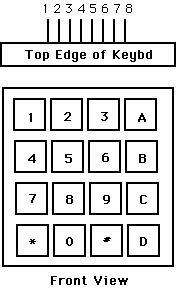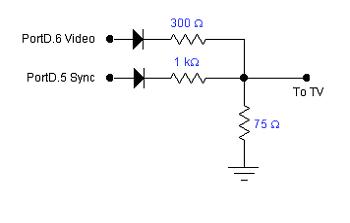ECE 476 Final Project, Spring 2003
Jeannette Lukito :: Jonathan Wang
:Introduction:
:High.Level.Design:
:Program.Design:
:Hardware.Design:
:Results:
:Pictures:
:Conclusions:
:Appendix:
:Code.of.Ethics:
Jeannette Lukito
jl259@cornell.edu
Jonathan Wang
jdw24@cornell.edu

The list of hardware used to create the device is as follows:
- Atmel Mega32 microcontroller chip with 16 MHertz Crystal
- Atmel STK500 development board
- 2 4x4 keypads
- a 2-bit Video DAC
- 5-inch TV

The keypad:
The keypad has the following configuration:

Pin 2 -- row 4 5 6 B
Pin 3 -- row 7 8 9 C
Pin 4 -- row * 0 # D
Pin 5 -- col 1 4 7 *
Pin 6 -- col 2 5 8 0
Pin 7 -- col 3 6 9 #
Pin 8 -- col A B C D
(a) Each switch shorts one row to one column.
(b) Each pin should be connected to one bit of an i/o port.
(c) The i/o port pins will be used both as inputs and outputs. When they are inputs, they should have active pullup resistors.
Video DAC:
The simple 2-bit DAC for the TV has the following configuration:

Video generation deals mainly with sync generation and image generation. I covered sync generation in the interrupt section. Images are stored in an 800 byte array in the MEga32 RAM. There are 8 bits per byte, so that there are a total of 6400 points. RAM is copied into registers v1-v8, and then blasted out as fast as possible to make a dense raster.